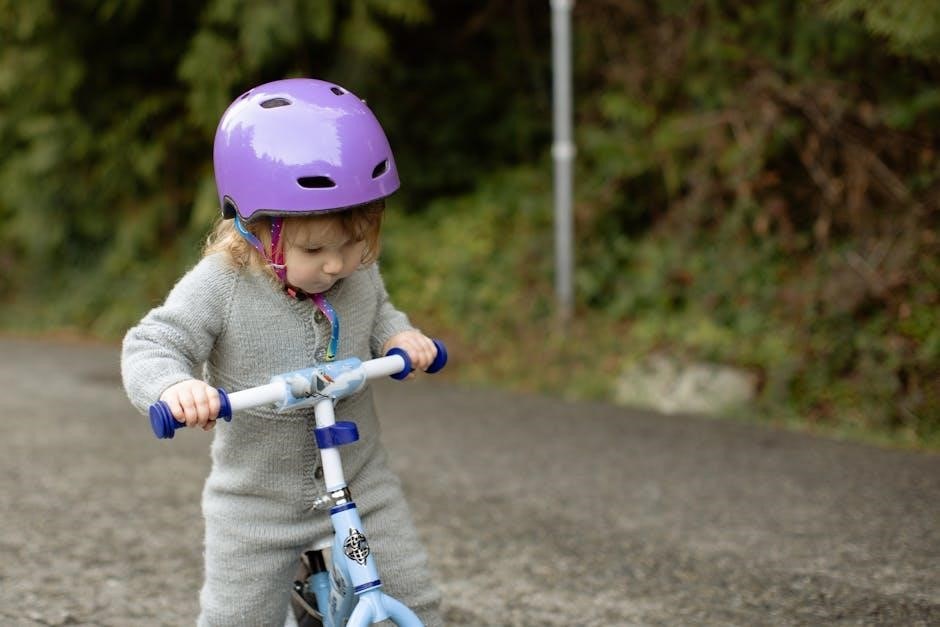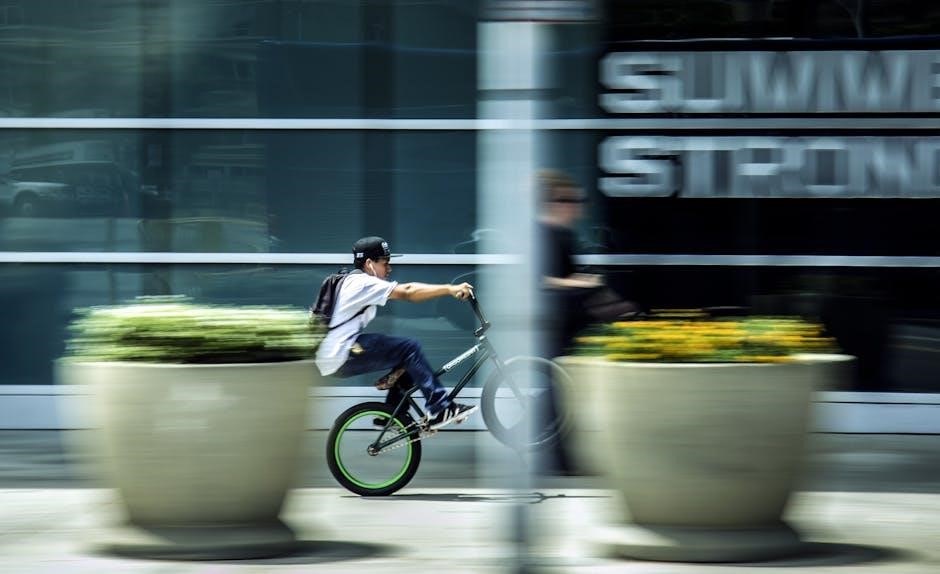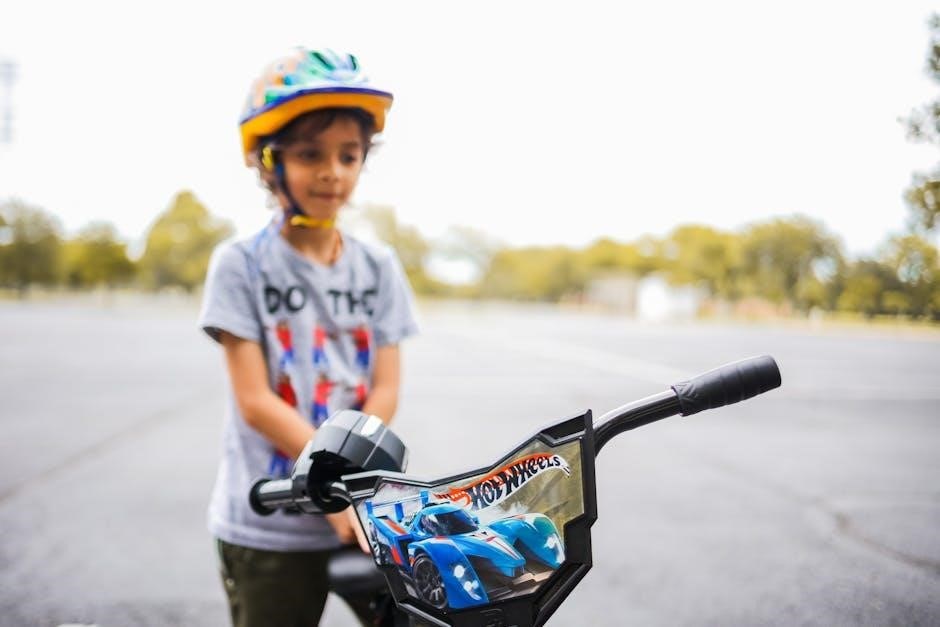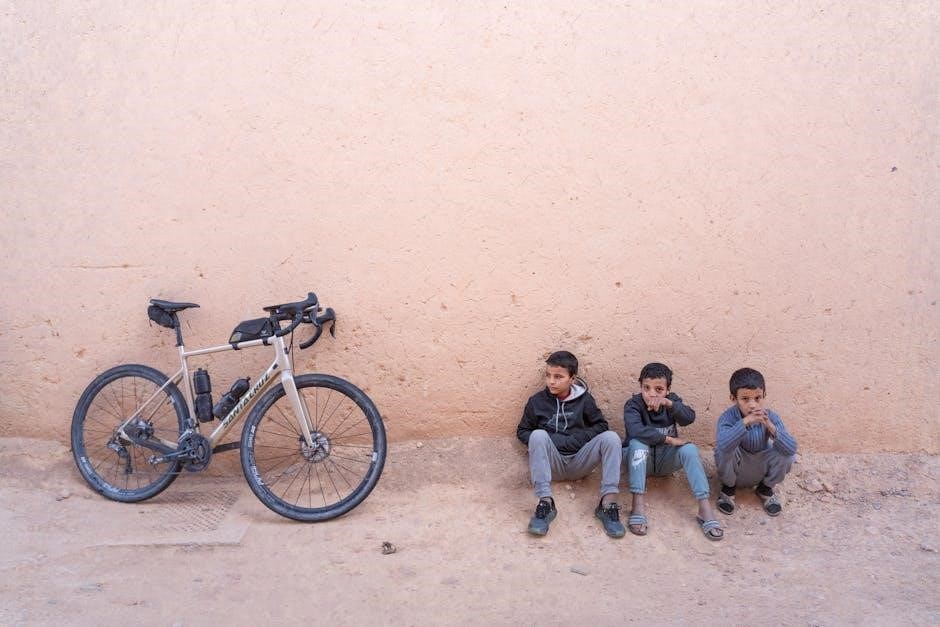A child’s bike helmet is essential for safety and comfort, ensuring proper fit and protection. This guide helps you find the correct size for your child.
Why Proper Helmet Fit is Crucial for Safety
A properly fitting helmet is critical for ensuring your child’s safety while biking. A helmet that is too loose or too tight may not provide adequate protection in the event of an accident. Poorly fitting helmets can shift during impact, leaving vulnerable areas exposed. This increases the risk of head injuries, which can be severe or even life-threatening. A well-fitting helmet stays securely in place, distributing force evenly and reducing the likelihood of injury. Proper fit also ensures comfort, encouraging your child to wear the helmet consistently. Always prioritize correct sizing and adjustment to maximize safety and peace of mind.

How to Measure Your Child’s Head
To measure your child’s head, use a flexible tape measure around the largest part, about one inch above the ears and eyebrows for accurate sizing.
Tools and Techniques for Accurate Measurement
To ensure accurate head measurement for your child’s bike helmet, use a flexible tape measure. Place it around the largest part of their head, about one inch above the eyebrows and ears.
Hold the tape measure level and snug but not too tight. This method provides a precise circumference reading, essential for selecting the correct helmet size. Avoid using string or other non-flexible tools, as they may not provide an accurate fit. For the best results, measure your child’s head multiple times to confirm consistency. Proper measurement ensures the helmet will fit comfortably and provide optimal protection. Always refer to the helmet’s size chart after obtaining an accurate measurement. This step is crucial for both safety and comfort during bike rides.
Step-by-Step Guide to Measuring Head Circumference
- Gather a flexible tape measure and ensure your child is sitting straight.
- Place the tape measure around the widest part of their head, slightly above the eyebrows and ears.
- Hold the tape snug but not too tight to ensure an accurate reading.
- Measure multiple times to confirm consistency, as head sizes can vary slightly.
- Record the circumference in centimeters to match it with the helmet size chart.

For children aged 0-11 months, the average head size is 33.9-45.8 cm, while 1-year-olds typically range from 46-50 cm. Older children (1.5-2 years) usually measure 49-51 cm, increasing with age.

Child Bike Helmet Size Chart
- Infants (0-11 months): 33.9-45.8 cm head circumference.
- Toddlers (1-2 years): 46-51 cm for proper fit.
- Children (2-4 years): 51-53 cm for safety.
Age Groups and Corresponding Head Sizes
Understanding the relationship between age and head size is key to selecting the right helmet. Infants (0-11 months) typically have head circumferences ranging from 33.9 to 45.8 cm. Toddlers aged 1-2 years usually measure between 46 and 51 cm. Children aged 2-4 years generally have head sizes from 51 to 53 cm. These measurements ensure proper fit and safety. Youth sizes, for older children, often range from 50-55 cm. Matching these age groups with appropriate head sizes guarantees a secure and comfortable fit, which is essential for protection while biking.
Size Ranges for Different Helmet Models
Helmet models vary in size to accommodate different head sizes. Child-sized helmets typically range from 45 to 54 cm in circumference, catering to younger riders. Youth or extra-small helmets are designed for slightly larger heads, often measuring between 50-55 cm. Small helmets generally fit heads from 51-57 cm, while medium-sized helmets cover 54-60 cm. Some models offer overlapping sizes, such as small/medium (51-58 cm), to ensure a more precise fit. These size ranges help parents choose helmets that align with their child’s specific measurements, ensuring both comfort and safety. Proper sizing is essential for effective protection while biking. Always check the manufacturer’s size chart for accuracy.
How to Fit the Helmet Correctly
Fitting a child’s helmet involves placing it level on their head, ensuring the front sits just above the eyebrows. Adjust straps for a snug, secure fit that allows clear vision and unrestricted movement while keeping the helmet stable during rides.
Adjusting the Straps and Buckles
Properly adjusting the straps and buckles ensures a secure and comfortable fit. Start by placing the helmet level on your child’s head, just above the eyebrows. Tighten the rear dial to snug the helmet around the back. Next, adjust the side straps so they form a “V” shape around the ears, meeting just below the earlobe. Finally, fasten the chin strap securely, ensuring it’s snug but not too tight. Test the fit by gently tugging the helmet forward and backward; it should stay in place. Adjustments may be needed to ensure the helmet doesn’t shift during movement, providing reliable protection and comfort for your child.
The “Fit Check” to Ensure Proper Placement
After adjusting the straps and buckles, perform a “Fit Check” to confirm the helmet sits correctly. Ensure the helmet is level, resting low on the forehead, and the front edge is no more than one inch above the eyebrows. Check that the straps form a “V” around the ears and meet just below the earlobe. The chin strap should be snug, allowing no more than two fingers between the strap and the chin. Gently tug the helmet forward and backward to ensure it doesn’t shift excessively. If it moves too much, tighten the rear dial or adjust the straps. Proper placement ensures optimal protection and comfort for your child while riding.
Additional Features to Consider
Look for helmets with safety certifications, padding, ventilation, and adjustable visors. Ensure the helmet meets CPSC or ASTM standards for optimal protection and comfort.
Safety Certifications and Standards
When selecting a child’s bike helmet, ensure it meets rigorous safety standards. Look for certifications from organizations like the Consumer Product Safety Commission (CPSC) or ASTM International. These standards verify that the helmet provides adequate protection in the event of an impact, ensuring it can absorb shock and distribute force effectively. Many helmets also meet Snell Memorial Foundation standards, which are among the most stringent. Always check for a certification sticker inside the helmet, as it indicates compliance with safety regulations. These standards cover aspects such as impact resistance, coverage area, and retention system strength, ensuring your child’s helmet is both reliable and protective.

Other Important Features for Comfort and Safety
Beyond size and fit, consider additional features for your child’s helmet. Ventilation is crucial for breathability, preventing overheating during rides. Look for helmets with multiple vents to ensure airflow. Padding is another key feature; removable and washable pads enhance comfort and hygiene. An adjustable dial or fit system allows for fine-tuning the helmet’s fit as your child grows. A visor or sunshade can protect your child’s eyes from glare. Some helmets also include a built-in rear light for increased visibility. Finally, ensure the helmet has a secure buckle and straps to keep it in place. These features collectively enhance both comfort and safety, making every ride more enjoyable and secure for your child.
Choosing the right child bike helmet ensures safety and comfort. Measure accurately, check fit, and consider features for a perfect match to protect your child while riding.
Final Tips for Choosing the Right Helmet
When selecting a child bike helmet, prioritize proper fit and safety certifications. Ensure the helmet fits snugly, with straps forming a “V” under the ears and the buckle centered. Opt for bright colors or reflective elements to enhance visibility. Consider features like ventilation for comfort and adjustable pads for a customizable fit. Always check for safety standards such as CPSC or ASTM certification. Avoid helmets with loose padding or worn-out straps, as they may compromise protection. Encourage your child to wear the helmet consistently, setting a good safety example. Regularly inspect the helmet for damage and replace it if necessary, especially after a crash.